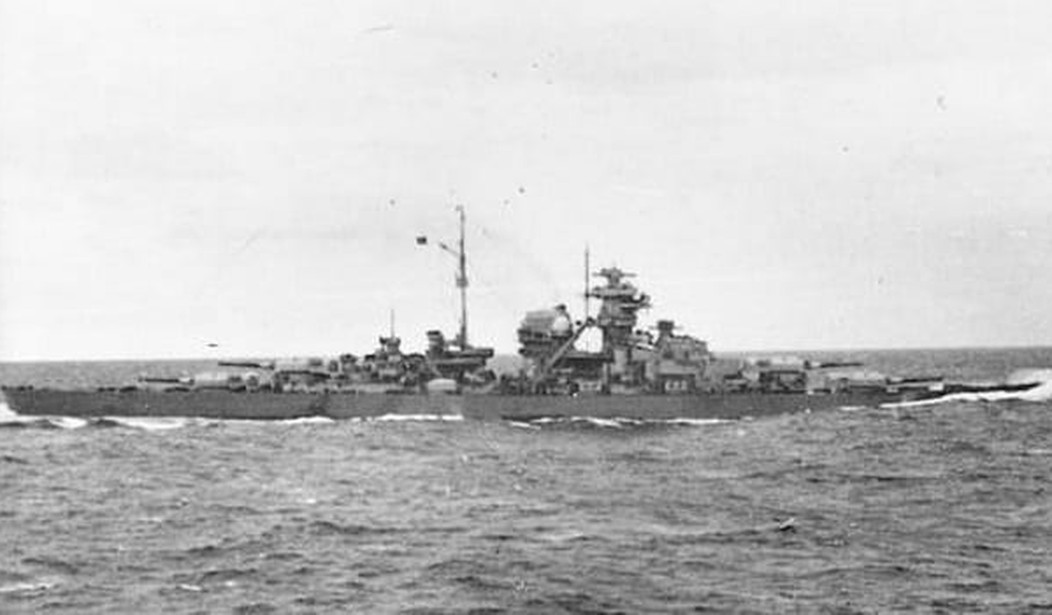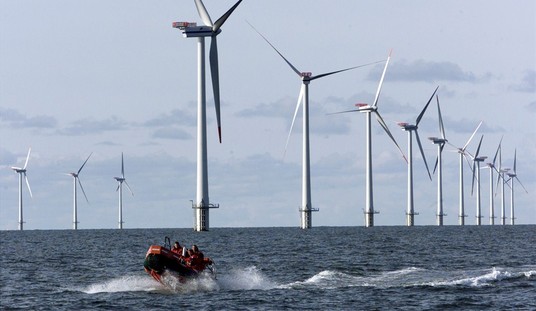
On May 18, 1941 the Bismarck and her consort Prinz Eugen sortied from the Pomeranian port of Gotenhafen, present day Gdynia, Poland, to raid British commerce in the North Atlantic. The Bismarck, displacing some 50,000 tons, had been launched in 1939 and was a formidable combatant carrying 8 x 15 guns as her main battery. When she entered service on August 24, 1940 the only European warship larger than Bismarck was HMS Vanguard. On May 20, a Swedish cruiser, Gotland, sited the pair and the Swedes, being the good neutral power that they were, promptly informed the British. The British were predictably and understandably exercised.
The commander of the Home Fleet, Admiral Sir John Tovey, ordered the HMS Hood and HMS Prince of Wales and six destroyers to sortie to intercept Bismarck and Prinz Eugen. In late afternoon on May 23, HMS Suffolk spotted Bismarck and Prinz Eugen in the Denmark Strait, the body of water separating Iceland and Greenland. Suffolk reported this contact and shortly afterwards HMS Norfolk, also a cruiser, spotted them. Both Hood and Prince of Wales accelerated to intercept them.
At 5:45am on May 24 a lookout on Hood spotted the pair of German ships. At 5:52 Hood opened fire at a range of about 13 miles, in short order the Prince of Wales also opened fire. Bismarck and Prinz Eugen returned fire; Prinz Eugen struck Hood on her boat deck setting off a large fire in the ready-use ammunition. Not a big deal. But at 6am, Bismarck fired her fifth salvo from about 9.5 miles. One or more of the eight 15-inch round hit Hood at a downward angle through her lightly armored deck and exploded in her magazine. Hood blew up and sank in three minutes. Only three of the 1,418 officers and men aboard survived.
Both Prinz Eugen and Bismarck turned their attention to Prince of Wales and her captain decided to break off the action at 6:05am.
In an effort to split up British forces, the German admiral, Guenther Luetjens, sent Prinz Eugen away to raid independently. The tactic didn’t work. The Home Fleet concentrated on Bismarck. What ensued was an epic chase with the Bismarck beset by Swordfish torpedo planes and leaking oil from its bunkers because of torpedo and gun damage and the Home Fleet running low on fuel and fearful of German U-boats.
On May 25, the British lost contact with Bismarck and near panic ensued. Signal intercepts were misplotted which showed the Bismarck heading back towards Norway. Finally, this was righted after the fleet had steamed in the wrong direction for seven hours. At 10:10am on May 26, a PBY Catalina launched from Lough Erne in Northern Ireland, piloted by US Navy Ensign Leonard B. Smith, spotted Bismarck. By late afternoon, the carrier HMS Ark Royal was within striking distance. The first wave mistook HMS Sheffield for Bismarck and attacked. Fortunately, the torpedoes had magnetic detonators which failed to function… and the crew of Sheffield had brown trousers. Ark Royal’s Swordfish torpedo planes rearmed, this time with torpedoes using old-school contact detonators, and launched at 7:10pm. At 8:47pm, they attacked Bismarck. One torpedo struck Bismarck amidships and resulted in minor flooding (minor being a matter of perspective). A second torpedo, launched by former London bus driver, John Moffat, struck the stern of Bismarck and jammed the rudder assembly. Bismarck could only turn to port, left.
At 9:40pm, Luetjens reported Bismarck could not be maneuvered. But darkness brought no respite.She was harassed by HMS Sheffield and the Polish destroyer ORP Piorun. Bismarck suffered no further damage but that was something of a hollow victory for the battleships HMS George V and HMS Rodney closed as the Bismarck cut a large circle in the North Atlantic. Around 8:47am on May 27, HMS Rodney opened fire at a range of about 14 miles. At 9:02am Rodney scored a hit which damaged Bismarck’s forward two turrets. By 9:31, Bismarck’s main battery was out of action. When Rodney and George V ceased fire at 10:20 they had fired over 700 rounds from their main battery, the last fired by Rodney were a range of under two miles.
Bismarck capsized at 10:35 and disappeared under the waves at 10:40.
The demise of the Bismarck effectively brought the German naval effort in World War II to an end.
The wreck of Bismarck was discovered in 1989:
The wreck of Bismarck was discovered on 8 June 1989 by Dr. Robert Ballard, the oceanographer responsible for finding RMS Titanic. Bismarck was found to be resting upright at a depth of approximately 4,791 m (15,719 ft),[129] about 650 km (400 mi) west of Brest. The ship struck an extinct underwater volcano, which rose some 1,000 m (3,300 ft) above the surrounding abyssal plain, triggering a 2 km (1.2 mi) landslide. Bismarck slid down the mountain, coming to a stop two-thirds down.[130]
Ballard’s survey found no underwater penetrations of the ship’s fully armoured citadel. Eight holes were found in the hull, one on the starboard side and seven on the port side, all above the waterline. One of the holes is in the deck, on the bow’s starboard side. The angle and shape indicates the shell that created the hole was fired from Bismarck ’s port side and struck the starboard anchor chain. The anchor chain has disappeared down this hole.[131] Six holes are amidships, three shell fragments pierced the upper splinter belt, and one made a hole in the main armour belt.[132] Further aft a huge hole is visible, parallel to the aircraft catapult, on the deck. The submersibles recorded no sign of a shell penetration through the main or side armour here, and it is likely that the shell penetrated the deck armour only.[133] Huge dents showed that many of the 14 inch shells fired by King George V bounced off the German belt armour.[134]
Ballard noted that he found no evidence of the internal implosions that occur when a hull that is not fully flooded sinks. The surrounding water, which has much greater pressure than the air in the hull, would crush the ship. Instead, Ballard points out that the hull is in relatively good condition; he states simply that “Bismarck did not implode.”[135] This suggests that Bismarck ’s compartments were flooded when the ship sank, supporting the scuttling theory.[136] Ballard added “we found a hull that appears whole and relatively undamaged by the descent and impact”. They concluded that the direct cause of sinking was scuttling: sabotage of engine-room valves by her crew, as claimed by German survivors.[137] Ballard kept the wreck’s exact location a secret to prevent other divers from taking artefacts from the ship, a practice he considered a form of grave robbing.[129]
The whole stern had broken away; as it was not near the main wreckage and as of 2015 had not been found, it can be assumed this did not occur on impact with the sea floor. The missing section came away roughly where the torpedo had hit, raising questions of possible structural failure.[138] The stern area had also received several hits, increasing the torpedo damage. This, coupled with the fact the ship sank “stern first” and had no structural support to hold it in place, suggests the stern detached at the surface. In 1942 Prinz Eugen was also torpedoed in the stern, which subsequently collapsed. This prompted a strengthening of the stern structures on all German capital ships.[137]













Join the conversation as a VIP Member